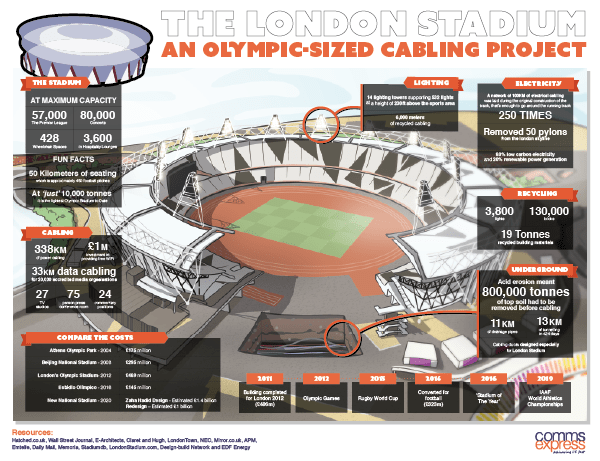
When London won the 2012 Summer Olympics in a head-to-head race with Paris in 2005 by the slim margin of just 54 to 50 votes, the victory was celebrated like a gold medal win by athletes and fans across the UK. The UK would get to host the world’s greatest sporting event for the first time since 1948 and the feeling of excitement was tangible in the country.
A core element of any bid for the Olympics is the stadium that will become the focus for the event, and London was no different.
The construction of the Olympic Park – and its centrepiece, the Olympic stadium – are vital to a successful Olympic games. But what goes into such a crucial construction project when the eyes of the world are watching your every move?
Laying The Groundwork
With soil in the Stratford area notorious for acid erosion, little building work could begin until the land had been prepared and this alone was no small feat! To allow 13 km of tunnelling, 800,000 tonnes of topsoil had to be removed.
This tunnelling then required specially designed ducts that would enable vital drainage and cabling to run through the ground. This extensive preparation work contributed significantly to the stadium becoming the most expensive Olympic stadium in history, although this cost will be surpassed by the re-design for the New National Stadium that is being built for the 2020 games in Japan.
Green Building Credentials
A large number of recycled materials went into this construction as the organisers wanted to show off their green credentials. In doing so, they would recycle 3,800 lights and power the games using green energy, with 20% coming from renewable power generation.
Also, 19 tonnes of recycled materials would be used in the overall project, including 130,000 bricks from the area cleared to make way for the games.
Cabling The Games
The recycling efforts didn’t stop there, with 6 km of cables recycled in the lighting alone. The lighting was a crucial element of this project since the attention of the world’s media would be firmly on the games and there would be no escaping the demands for high-quality video to be sent around the world.
Key moments like Sir Mo Farah winning gold were captured by 27 studios and 24 commentary positions inside the stadium. This required a monumental 338 km of power cabling and a £1 million investment in Wi-Fi alone.
Leaving A Legacy
In 2016, the legacy of the 2012 Olympics was realised when the stadium was converted for lead tenants West Ham from the English Premier League. The project would cost £323 million and would allow the stadium’s primary purpose to be changed, whilst maintaining the ability to host other sporting events, most importantly athletics.
Since the games, the stadium has been the venue for Rugby World Cup games and athletics events, and it will be hosting cricket and the IAAF World Championships in future.
This rounded sporting legacy is something that many critics dispute though, as the original bid stated that the stadium would remain as an athletics-first venue. However, with rival bids ranging from universities to other football clubs, West Ham won the bidding process on the basis that they could provide high levels of football and the flexibility to host sporting and music events in future.
A Huge Undertaking
It is clear that a construction project like the London Stadium represented a significant construction challenge, especially with the Stratford site conditions. However, the organisers overcame these challenges and managed to implement greener building practices too, which go hand-in-hand with successfully hosting the greatest sporting event in the world.
With the constantly developing story of the construction of the New National Stadium for the 2020 games, we’ll be keeping an eye on that project to see how it compares to the London Stadium.
Embed This Infographic On Your Website:
